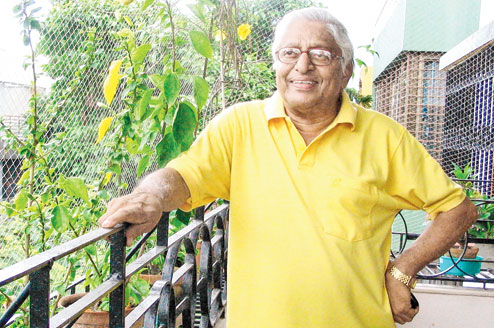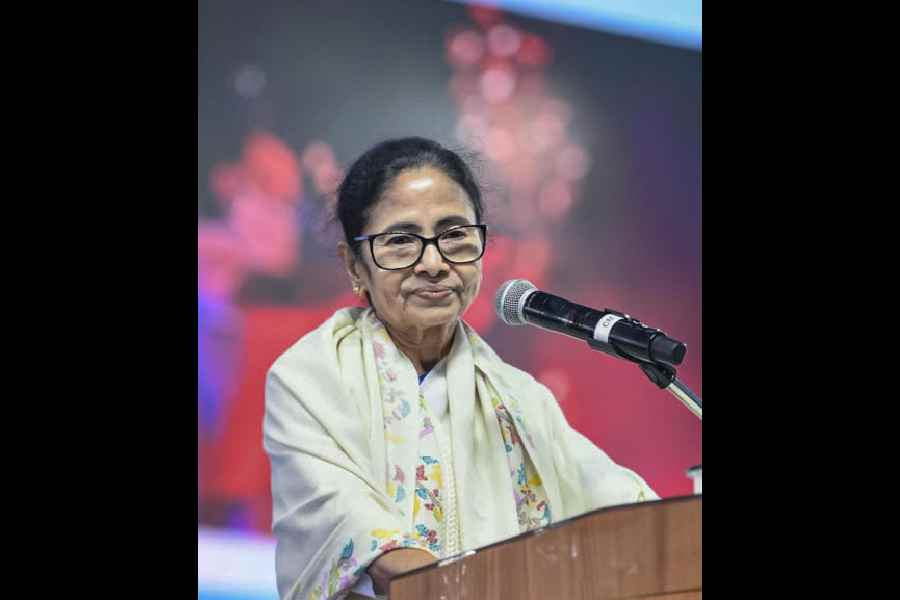 |
| Chuni Goswami at his Jodhpur Park home. Picture by Sudeshna Banerjee |
On the eve of Mohun Bagan Day (July 29), Olympian and Mohun Bagan Ratna Chuni Goswami speaks of a lesser-known facet of his career which fetched him a Lifetime Achievement Award last Sunday from the Cricket Association of Bengal.
Few people knew you were a cricketer first. To them, the CAB Lifetime Achievement Award came as a surprise.
After so many decades of playing football it is natural that people would remember me as a footballer. But I was a passionate cricketer too. Earlier, there was this culture of playing multiple sports in Calcutta.
Do you remember your first cricket match?
I was in Tirthapati Institution then. My classmate, author Buddhadeb Guha, would not take me in the cricket team as he thought I could not play a more difficult game than football. One day, some of the boys did not turn up for a match at Deshapriya Park. I was on the sidelines. When wickets fell in a heap, he was forced to send me out to bat. I scored 45 not out and secured my place in the team.
How would you rate yourself as a cricketer?
As a 14-year-old, I attended the Bengal school team trials for the Cooch Behar Trophy. The selectors were Bert Wensley (a Sussex all-rounder) and Pearson Surita (the cricket commentator). My football coach Balai Chatterjee, who coached India in the 1948 Olympics, had taught me to be always active at any selection camp. There were 30-40 boys, yet Wensley took note of me. “I will call you Tich,” he said. There used to be a leg break bowler in England by that name (Tich Freeman, the only bowler to have taken 300 wickets in an English season). He announced on the third day: “Tich, you’ll bat a bit, bowl a bit, field a bit.” I am that bits-and-pieces cricketer. I couldn’t bat like Sachin Tendulkar or bowl like Kapil Dev. At best, I could field like Eknath Solkar. But I made the most of my limited strengths. That’s how I became an automatic choice for Bengal and the combined zone.
What is your most significant cricket memory?
That has to be the 1966-67 series when we defeated Gary Sobers’s West Indies at Indore in a first class match. West Indies refused to play too many matches. So central and east zones were combined to form a team. There were murmurs regarding my selection as I hadn’t done much yet for Bengal. So I was under pressure to justify my place. Though Sobers wasn’t playing, it was a strong line-up featuring Rohan Kanhai, Conrad Hunt and Basil Butcher. I took five wickets in an innings including that of Kanhai, and eight in the match. I also scored some runs against the likes of Wes Hall and Charlie Griffith. We won by an innings and 10 runs. I also took two outstanding catches. The one I took running from mid-on to deep square leg has been mentioned by Sobers in his book.
There is this trend emerging in cricket of players placing club over their national team. We saw Kevin Pietersen recently refuse to play for England when IPL is on. Could such a situation be foreseen in your time?
IPL is a very lucrative sports league. Where is that kind of money in cricket anywhere else or even in our club football? In any case, the club pays the players yearly salaries. The (football) federation would pay daily allowances when one is on national duty, not before or after that. So the players are bound to feel attached to their club. We got £5 as weekly allowance when we played the Rome Olympics in 1960. As a professional footballer, Jarnail Singh was then making Rs 20,000 a year from the club.
Didn’t you get any payment from the club?
Never. It was known that Chuni-(Sailen)Manna do not take money to play for Mohun Bagan. It was a matter of pride for us. It was the same in English cricket too. There were separate dressing rooms marked ‘gentlemen’ and ‘players’. C.B. Fry, Douglas Jardine, Peter May were amateurs and hence, gentlemen. Ken Barrington, Alec Bedsar, Len Hutton and Denis Compton were professionals and were denied entry in the same dressing room. The distinction was done away with in 1952 when Hutton became the captain of England. Mohun Bagan-ey practice er por club theke ekta Singapuri ar toast dito, shei onek chhilo (We got a banana and a piece of toast after practice at Mohun Bagan. That was enough). There was no scope to ask for money. It helped when I got a job in 1960 with the State Bank of India. My salary of Rs 450 in those days was more than what an IAS officer drew.
Indian cricketers have been playing English county cricket for ages and largely benefitted by the exposure. Do you think it augurs well for Indian football if our players follow in the footsteps of Sunil Chetri who has signed for Sporting Lisbon of Portugal?
It all depends on how they fare. Baichung (Bhutia) had also gone (to FC Bury, England). I don’t remember how many matches they let him play. If Sunil or Mehtab (Hossein, the midfielder who has gone to the UK for trials) play decently, the clubs might want to retain them. After all, our players come cheaper than players from the West. This might start a trend.
Hadn’t you too got an offer to play abroad?
Yes. After India won gold under my captaincy at the Jakarta Asiad in 1962, Tottenham Hotspur got in touch with me through an acquaintance inviting me for a trial. In the end, though, I did not travel to England for the trial. There was too much of an uncertainty in choosing a career abroad. I was captain of Mohun Bagan, had a good job. My family was also tolerably well-off. The supporters here loved me. Dhiren-da (Dey, the legendary administrator of Mohun Bagan) told me: “What will you do there, staying all alone?” So I did not go.
Which team would you put your money on in this Olympic Games?
It is difficult to predict in an under-23 tournament. Brazil and Spain are traditionally strong contenders. Though Spain has lost the first match, they can come back. Much is being said of Neymar. Though I do not agree with Pele who thinks he is better than Messi, he certainly is a talent to watch out for.










